You have 0 product(s) in your cart.
Abyss Scuba Diving
Conservation Efforts And Challenges For Grey Nurse Sharks: An In-depth Look
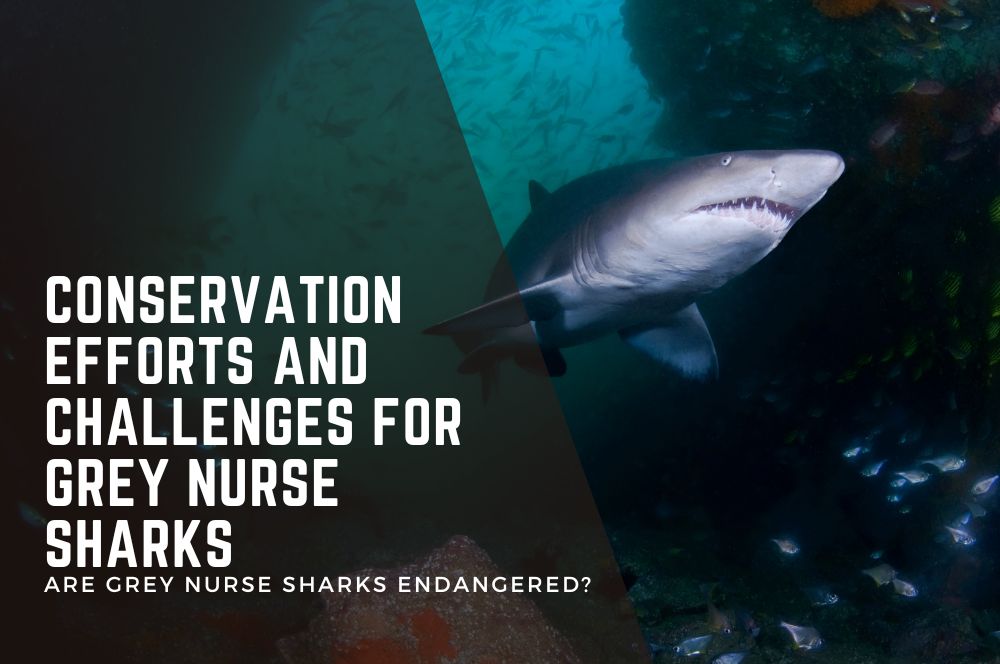
Conservation Efforts and Challenges for Grey Nurse Sharks: An In-depth Look
Grey nurse sharks are navigating the treacherous waters of endangerment. This article looks closely at the species, revealing why their existence is under threat and detailing the conservation measures aimed at preventing their decline.
Key Takeaways
-
Grey nurse sharks are a critical species with unique physical features and specialised reproductive habits which make them susceptible to population pressures.
-
Human activities such as pollution, fishing, and the use of shark nets have had severe impacts on the grey nurse shark populations, leading to their current endangered status.
-
Conservation efforts, including habitat restoration, fishing regulations, and public awareness campaigns, are imperative for the recovery and survival of grey nurse sharks.
Grey Nurse Shark Overview
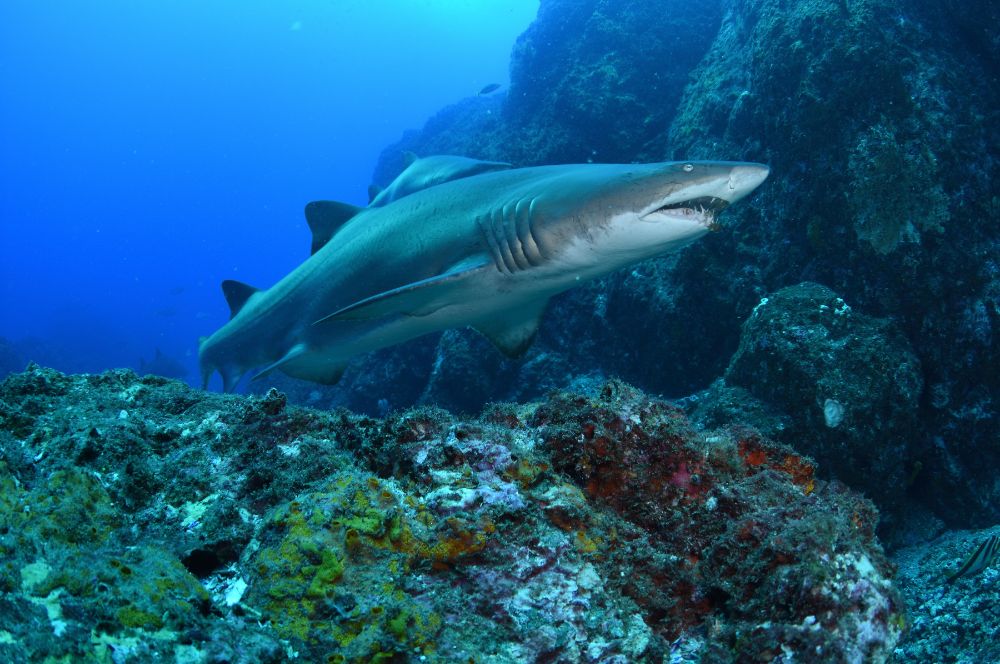
Stealthily patrolling the coastal waters, the protected shark, grey nurse shark, or shark Carcharias taurus, is a creature of both beauty and intrigue. Known by many names – sand tiger shark, spotted ragged-tooth shark, or simply nurse shark – these formidable predators are distinguished by their robust, stout bodies, reaching lengths of up to 3.6 meters. Grey nurse sharks found in various regions have grey-brown, dorsally coloured skin adorned with reddish or brownish spots, allowing them to blend seamlessly with the ocean floor.
At night, these sharks come alive, engaging in hunts that reveal the sharp teeth and powerful pectoral fins that make them such efficient predators.
Unique Features
Perhaps the most striking feature of the grey nurse shark is its set of fang-like teeth, which remain visible even when its mouth is closed, lending it a ferocious appearance. Yet, these pointed teeth and stout body are a testament to millions of years of evolution, perfectly designed for seizing prey in the dark waters they inhabit.
The reddish or brownish spots and stripes that decorate their bodies are not just for show; these patterns are nature’s camouflage, allowing the grey nurse shark to lurk unseen amongst the sandy and rocky seafloor, ever the silent hunter.
Grey Nurse Shark Habitat
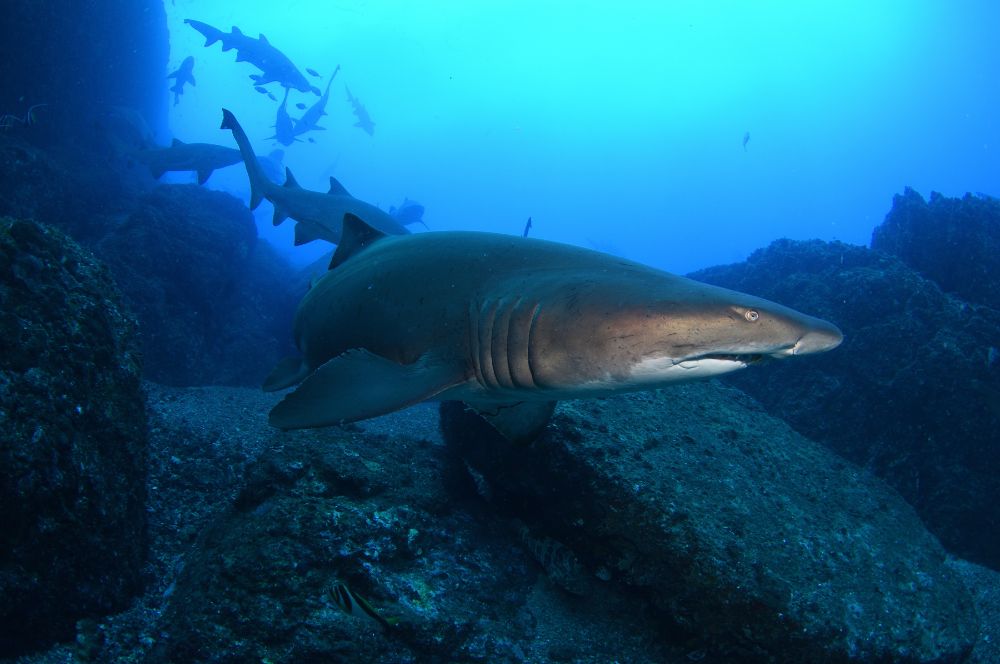
The diversity of the ocean’s topography matches the variety of creatures that inhabit it, including the grey nurse shark. Preferring the calm of sandy-bottomed gutters, the sanctuary of rocky caves, and the complexity of inshore rocky reefs, these sharks have carved out a niche in the temperate waters along the Australian coast. Here, they find the seclusion and resources necessary for their survival.
East Coast Population
The east coast population of grey nurse sharks, designated as ‘critically endangered’, has become a key focus of conservation efforts. With estimates once as low as 500 individuals, recent studies suggest numbers closer to 2,000, though this recovery is fragile at best. The sharks’ range stretches from Cooktown in Queensland to Jervis Bay in New South Wales, with their habitats being a mosaic of sandy gutters and shadowy caves.
Despite the quiet determination of volunteer divers, such as those in the ‘Saving Norman’ campaign, the population’s quasi-extinction history hangs like a spectre over current numbers, emphasising the need for continued vigilance.
West Coast Population
On the other hand, the west coast population, though not in as critical a condition as the Australian east coast population, is still classified as ‘Vulnerable’. These sharks patrol the waters from Houtman Abrolhos Islands to Ningaloo Reef in Western Australia, navigating a different set of challenges and human impacts.
The conservation status of this population serves as a reminder that even those not on the brink can quickly slip into peril without proper attention and protection.
Factors Leading to Endangerment
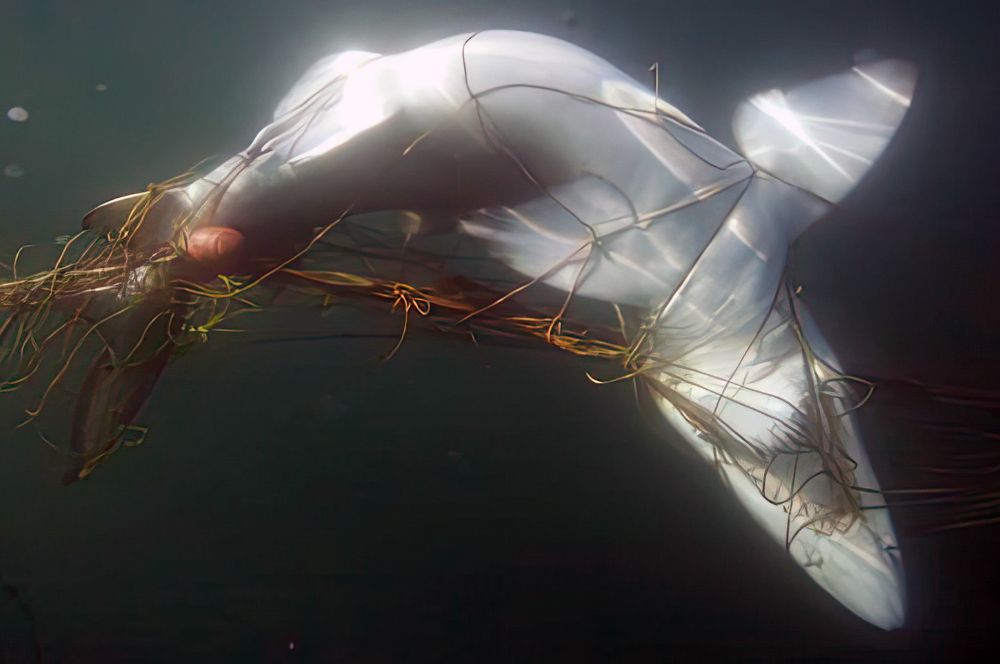
The decline of the grey nurse shark, the first protected shark, tells a story of human indifference and ecological neglect. In the mid-20th century, spearfishers targeted these sharks with such intensity that their numbers plummeted, setting in motion a chain of events that would lead to their current critically endangered status. Today, the threat persists, albeit in different forms – bycatch ensnares them, pollution chokes their habitats, and fishing opens wounds in already fragile populations.
The difficulty lies in balancing human interests with the needs of a species fighting for survival, a battle that conservationists wage daily.
Unique Reproductive Biology
The grey nurse shark’s battle for survival is further complicated by a reproductive process that is as intriguing as it is restrictive. Here are some key facts about their reproductive process:
-
Gestation period of up to a year
-
Yield of only two pups every other year
-
Birth rates are alarmingly low
-
Females do not breed until well into their teens
The phenomenon of intrauterine cannibalism, where the strongest embryos consume their siblings, further reduces the number of young sharks entering the population. This unique reproductive biology is a double-edged sword, ensuring the survival of the fittest while making the species extremely vulnerable to population pressure.
Human Impact and Threats
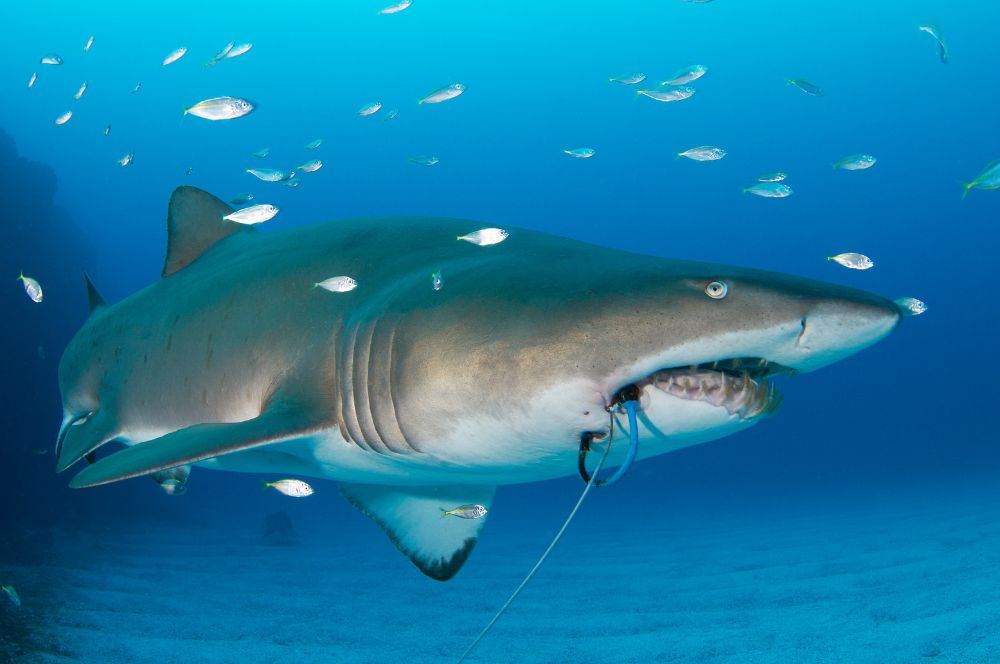
Humanity’s footprint on the marine environment is indelible, and the grey nurse shark bears the scars of our presence. The water they swim in is degraded by pollution, and ingested fishing hooks can inflict irreversible harm. Recreational and commercial fishing practices, often indiscriminate, threaten these sharks with accidental injury or death.
Furthermore, beach safety nets meant to protect swimmers inadvertently ensnare grey nurse sharks, leaving them injured or worse. These human impacts serve as a stark reminder of our responsibility to the species with whom we share this planet.
Conservation Strategies
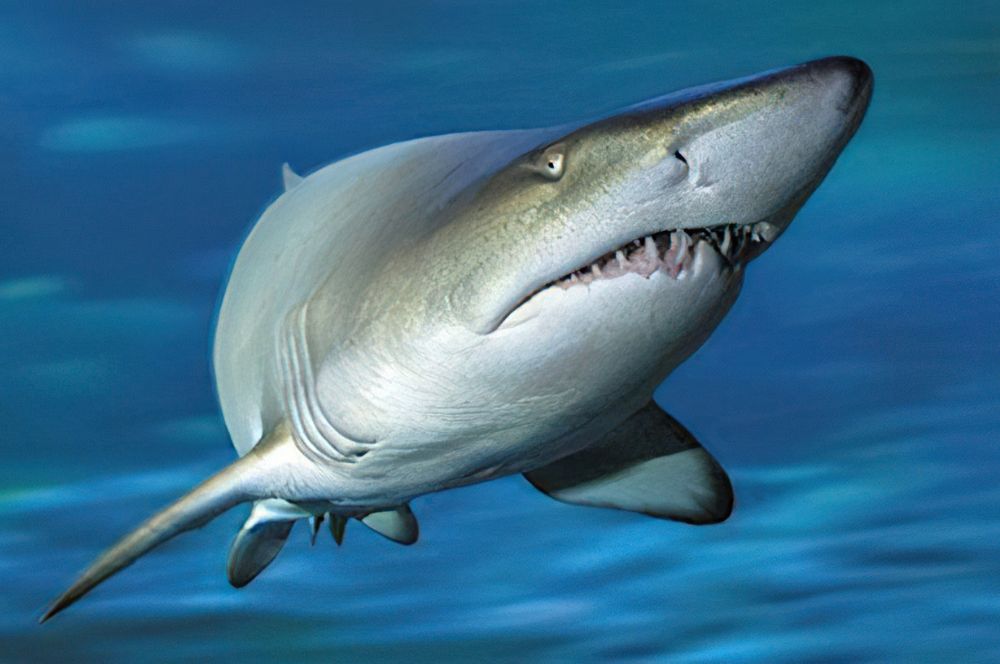
Despite the grim narratives, concerted conservation strategies provide a glimmer of hope. Groups are arduously working to create safe zones, restore critical habitats, and enforce fishing regulations that could afford grey nurse sharks a fighting chance. Research missions aim to peel back the layers of mystery surrounding these creatures, employing state-of-the-art technology in their quest to ensure a future for the species. It’s a multifaceted approach, encompassing everything from legal protection to habitat restoration, each element a crucial piece in the puzzle of grey nurse shark conservation.
Public Awareness Campaigns
The tide of public opinion can be powerful, and campaigns like ‘Saving Norman’ seek to harness this force for the benefit of grey nurse sharks. By shining a spotlight on the risks posed by shark nets and other harmful practices, these initiatives strive to educate the public and foster a sense of stewardship for the marine environment.
Raising awareness paves the way for change, empowering individuals through education to make decisions that promote the welfare of these endangered creatures.
Challenges in Conservation
Conservation is a road fraught with obstacles. The limited understanding of grey nurse shark biology presents a significant challenge, necessitating regular censuses to monitor their status. Fishing practices, often deeply ingrained in coastal communities, can be difficult to regulate or modify, especially when economic interests are at stake.
These challenges underscore the complexity of protecting a species on the brink, highlighting the necessity of a sensitive equilibrium between human activity and wildlife conservation.
Interaction with Humans
Despite their intimidating appearance, grey nurse sharks are not the villains of the deep that they were once believed to be. These gentle giants exhibit a remarkable lack of aggression towards humans, debunking myths that have long portrayed them as man-eaters, even though grey nurse sharks eat.
It is only in instances where they feel threatened, such as being cornered or when divers carry the scent of dead fish, that grey nurse sharks might display defensive behaviours. This understanding has been crucial in shifting the public’s perception and fostering a more harmonious coexistence between man and shark.
Diving Etiquette
While diving with grey nurse sharks can be a thrilling experience, it also brings with it an obligation to follow appropriate guidelines. Adhering to guidelines designed to protect these animals ensures their safety and well-being, as well as that of the divers. It’s a delicate dance between two species, one that, when performed with respect and care, can lead to encounters that are both awe-inspiring and educational.
Such interactions can serve as a potent reminder of our role in the broader ecosystem and the importance of preserving its delicate balance.
Summary
As we resurface from the depths of the grey nurse shark’s world, we carry with us a deeper understanding of their plight and the complex web of factors that influence their survival. From their unique biology to the threats they face and the conservation efforts in place, it’s clear that the path to their recovery is a collective journey. It’s a path paved with knowledge, empathy, and action – one that requires the commitment of individuals and communities alike.
Let this exploration serve as a call to action, a reminder that every choice we make has the potential to impact these majestic creatures. By choosing to be informed, engaged, and proactive, we become not just observers of their story but active participants in shaping a future where grey nurse sharks continue to thrive.
Frequently Asked Questions
What distinguishes the grey nurse shark from other shark species?
The grey nurse shark is distinguished by its stout body, pointed snout, distinct reddish or brownish spots, fang-like teeth, and nocturnal hunting habits. These features set it apart from other shark species.
Why are grey nurse sharks endangered?
Grey nurse sharks are endangered due to historical targeting by spearfishers, bycatch in fishing operations, habitat loss, and their reproductive biology that leads to low birth rates and late sexual maturity. These factors have contributed to their endangered status and continue to threaten their survival.
What is being done to conserve grey nurse sharks?
Efforts to conserve grey nurse sharks include establishing marine protected areas, implementing fishing regulations, habitat restoration programs, and public awareness campaigns like 'Saving Norman' to educate and encourage conservation behaviours. These measures aim to protect and promote the survival of the species.
Can humans safely interact with grey nurse sharks?
Yes, humans can safely interact with grey nurse sharks by following proper diving etiquette and guidelines for a safe and mutually beneficial experience.
What are the main challenges in conserving grey nurse sharks?
The main challenges in conserving grey nurse sharks are the limited knowledge about their biology, which complicates conservation strategies, and the difficulty of enforcing regulations in the face of competing human interests, such as fishing and coastal development. These challenges make it crucial to develop effective conservation measures.
Recent Posts






